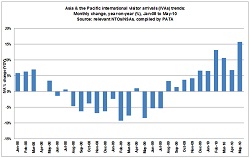ASIA PACIFIC For the first five months of 2010, international visitor arrivals to the Asia Pacific region grew by a robust 10% compared to the same period last year, Pacific Asia Travel Association reports.
Arrivals for the months of April and May grew 7% and 16%, respectively. However, there was a noticeable impact on air travel caused by the ash cloud from Iceland’s volcanic eruption, which dampened arrival flows to and from Europe. Growth was much stronger in May with the end of the ash cloud problem in Europe and the Labour Day holiday in China. However this monthly comparison is against a lower arrivals base in May 2009, when the travel industry, already down from the global recession, was hit further by the spread of the H1N1 flu.
International arrivals to South Asia grew by 4% and 19% in April and May, respectively, with the continuously improving safety and security situation helping to boost arrivals to the sub-region. Sri Lanka, one year on from the end of the decades-long civil war, continues to record robust growth in arrivals in April and May, at year-on-year rates of 47% and 42%, respectively. For the first five months of the year, arrivals to South Asia surged 15%, the fastest in terms of rate of growth among the sub-regions under review.
Arrivals to Southeast Asia grew by better than 8% year-on-year for both the months of April and May—comparatively slower than that seen in the first three months of the year, but robust nonetheless. Some slowdown can be attributed to the ash cloud disruption in April and the political turmoil in Thailand that negatively impacted visitor arrivals to the kingdom, which were down by 0.2% and 13% in April and May, respectively. With the exception of Thailand, arrivals to other Southeast Asia destinations remained robust. Overall, the sub-region recorded year-on-year growth of 13% in the first five months of the year.
Intraregional Travel Boosts Northeast Asia

The largest sub-region in terms of visitor volumes, Northeast Asia, registered a steady growth of 7% during April and a 19% increase during May. This has been supported by the large and robust intraregional flows within mainland China and Hong Kong and Macau, as well as the growing popularity of Taiwan as a nearby destination. Equally impressive was the growth in international arrivals to Japan which surged 26% and 49% in April and May, respectively. Japan is currently enjoying a period of buoyant recovery, recording six consecutive months of double-digit growth in arrivals since December last year, following a long slump. Overall, growth in international arrivals to Northeast Asia reached 10% for the first five months of the year.
Among the sub-regions, only the Pacific recorded overall declines in visitor numbers in April and May. Arrivals to Australia and New Zealand were down by 6% and 4%, respectively, for those two months, as the ash cloud disruption negatively impacted arrivals from Europe. The majority of the smaller Pacific island destinations also recorded declines in arrivals in April. Apart from the Northern Marianas, Palau and Tuvalu, growth in arrivals to the Pacific remained sluggish in May. For the first five months of 2010, visitor arrivals to the Pacific grew by a modest 2% as compared to the same period last year.
